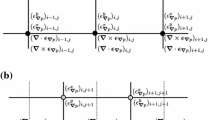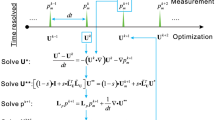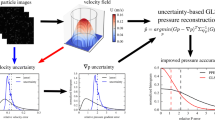Abstract
Particle image velocimetry (PIV)-based pressure reconstruction has become a popular technique in experimental fluid mechanics. Noise or errors in raw velocity field would significantly affect the quality of pressure reconstruction in PIV measurement. To reduce experimental errors in pressure gradient and improve the precision of reconstructed pressure field, a minimal 2-norm criteria-based new technique called irrotation correction (IC) with orthogonal decomposition is developed. The pressure reconstruction is therefore composed of three steps: calculation of pressure gradient from time-resolved velocity fields of PIV, an irrotation correction on the pressure gradient field, and finally a simple orthogonal-path integration (OPI) for pressure. Systematic assessments of IC algorithm are performed on synthetic solid-body rotation flow, direct numerical simulations of a channel flow and an isotropic turbulent flow. The results show that IC is a robust algorithm which can significantly improve the accuracy of pressure reconstruction primarily in the low wave number domain. After irrotation correction, noisy pressure gradient field ideally becomes an irrotational field on which the pressure integration is independent of integrating paths. Therefore, an OPI algorithm is proposed to perform the pressure integration in an efficient way with very few integration paths. This makes the new technique to be a doable method on three-dimensional pressure reconstruction with acceptable computational cost.










Similar content being viewed by others
References
Baur T, Köngeter J (1999) PIV with high temporal resolution for the determination of local pressure reductions from coherent turbulent phenomena. In: 3rd International workshop on particle image velocimetry, p 101
Charonko JJ, King CV, Smith BL, Vlachos PP (2010) Assessment of pressure field calculations from particle image velocimetry measurements. Measur Sci Technol 21(10):105401
Christensen KT, Adrian RJ (2002) Measurement of instantaneous eulerian acceleration fields by particle image velocimetry: method and accuracy. Exp Fluids 33:759
Dabiri JO (2013) A simple algorithm to estimate pressure fields from velocity field measurements. arXiv preprint arXiv:13036966
Dabiri JO, Bose S, Gemmell BJ, Colin SP, Costello JH (2014) An algorithm to estimate unsteady and quasi-steady pressure fields from velocity field measurements. J Exp Biol 217(3):331–336
Detert M, Weitbrech V, Jirka G (2007) Simultaneous velocity and pressure measurements using PIV and multi layer pressure sensor arrays in gravel bed flows. In: HMEM 2007, ASCE–Conference, Lake Placid
de Kat R (2012) Instantaneous planar pressure determination from particle image velocimetry. PhD thesis, Delft University of Technology
de Kat R, van Oudheusden BW (2012) Instantaneous planar pressure determination from PIV in turbulent flow. Exp Fluids 52(5):1089
de Kat R, van Oudheusden BW, Scarano F (2008) Instantaneous planar pressure field determination around a square-section cylinder based on time-resolved stereo-PIV. In: 14th International symposium on applications of laser techniques to fluids mechanics, p 1259
de Silva CM, Philip J, Marusic I (2013) Minimization of divergence error in volumetric velocity measurements and implications for turbulence statistics. Exp fluids 54(7):1–17
Foucaut JM, Carlier J, Stanislas M (2004) PIV optimization for the study of turbulent flow using spectral analysis. Measur Sci Technol 15(6):1046–1058
Garcia D (2011) A fast all-in-one method for automated post-processing of PIV data. Exp Fluids 50(5):1247–1259
Ghaemi S, Ragni D, Scarano F (2012) PIV-based pressure fluctuations in the turbulent boundary layer. Exp Fluids 53(6):1823
Graham J, Lee M, Malaya N, Moser R, Eyink G, Meneveau C, Kanov K, Burns R, Szalay A (2013) Turbulent channel flow data set. http://turbulence.pha.jhu.edu/docs/README-CHANNEL.pdf
Gresho PM, Sani RL (1987) On pressure boundary conditions for the incompressible Navier–Stokes equations. Int J Numer Methods Fluids 7(10):1111–1145
Gurka R, Liberzon A, Hefetz D, Rubinstein D, Shavit U (1999) Computation of pressure distribution using PIV velocity data. In: 3rd International workshop on particle image velocimetry, p 671
Jakobsen ML, Dewhirst TP, Greated CA (1997) Particle image velocimetry for predictions of acceleration fields and forces within fluid flows. Meas Sci Technol 8(12):1502
Joint Committee for Guides in Metrology (JCGM) (2008) Evaluation of measurement data guide to the expression of uncertainty in measurement available online: http://www.bipm.org/en/publications/guides/gum.html
Joshi P, Liu X, Katz J (2014) Effect of mean and fluctuating pressure gradients on boundary layer turbulence. J Fluid Mech 748:36–84. doi:10.1017/jfm.2014.147
Koeltzsch K (1998) On the relationship between the Lagrangian and Eulerian time scale. Atmos Environ 33(1):117–128
Koschatzky V, Moore PD, Westerweel J, Scarano F, Boersma BJ (2011) High speed PIV applied to aerodynamic noise investigation. Exp Fluids 50(4):863
Li Y, Perlman E, Wan M, Yang Y, Meneveau C, Burns R, Chen S, Szalay A, Eyink G (2008) A public turbulence database cluster and applications to study lagrangian evolution of velocity increments in turbulence. J Turbul (9):N31
Liu X, Katz J (2006) Instantaneous pressure and material acceleration measurements using a four-exposure PIV system. Exp Fluids 41(2):227
Liu X, Katz J (2008) Cavitation phenomena occurring due to interaction of shear layer vortices with the trailing corner of a two-dimensional open cavity. Phys Fluids 20(4):041702
Liu X, Katz J (2013) Vortex-corner interactions in a cavity shear layer elucidated by time-resolved measurements of the pressure field. J Fluid Mech 728:417–457
Perlman E, Burns R, Li Y, Meneveau C (2007) Data exploration of turbulence simulations using a database cluster. In: Proceedings of the 2007 ACM/IEEE conference on Supercomputing, ACM, p 23
Raffel M, Willert CE, Wereley ST, Kompenhans (2007) Particle image velocimetry. A practical guide
Tennekes H (1975) Eulerian and lagrangian time microscales in isotropic turbulence. J Fluid Mech 67(03):561–567
Thomas F, Liu X (2004) An experimental investigation of symmetric and asymmetric turbulent wake development in pressure gradient. Phys Fluids 16(5):1725–1745
Tsuji Y, Fransson JHM, Alfredsson PH, Johansson AV (2007) Pressure statistics and their scaling in high-reynolds-number turbulent boundary layers. J Fluid Mech 585:1
van Oudheusden BW (2013) PIV-based pressure measurement. Meas Sci Technol 24(3):032,001
van Oudheusden BW, Scarano F, Roosenboom EWM, Casimiri EWF, Souverein LJ (2007) Evaluation of integral forces and pressure fields from planar velocimetry data for incompressible and compressible flows. Exp Fluids 43(2–3):153
Violato D, Moore P, Scarano F (2011) Lagrangian and Eulerian pressure field evaluation of rod airfoil flow from time-resolved tomographic PIV. Exp Fluids 50(4):1057
Wang C, Gao Q, Wang H, Wei R, Li T, Wang J (2016) Divergence-free smoothing for volumetric PIV data. Exp Fluids 57(1):1–23
Wang H, Gao Q, Feng L, Wei R, Wang J (2015) Proper orthogonal decomposition based outlier correction for PIV data. Exp Fluids 56(2):43
Acknowledgments
This work is supported by the National Natural Science Foundation of China (11472030, 11327202, 11490552) and the Fundamental Research Funds for the Central Universities (Grant No. YWF-16-JCTD-A-05). We would like to thank Professor Charles Meneveau for providing the DNS data of channel flow and isotropic turbulent flow. We would also like to thank Dr. Liu Xiaofeng for his help on this work of pressure reconstruction techniques.
Author information
Authors and Affiliations
Corresponding author
Rights and permissions
About this article
Cite this article
Wang, Z., Gao, Q., Wang, C. et al. An irrotation correction on pressure gradient and orthogonal-path integration for PIV-based pressure reconstruction. Exp Fluids 57, 104 (2016). https://doi.org/10.1007/s00348-016-2189-6
Received:
Revised:
Accepted:
Published:
DOI: https://doi.org/10.1007/s00348-016-2189-6




